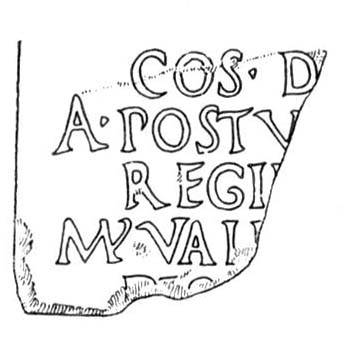PhD Top Stories
Valeria Dieci
The Regillensis cognomen and the tradition on the battle of the Regillus lake
Doctoral Programme in Scienze dell'Antichità (interateneo Università di Trieste – Udine – Venezia)
Within the Roman onomastic system, cognomina ex virtute fell into the category of agnomina, epithets that were placed alongside the cognomen so that an individual could also be identified by a personal characteristic, usually a military success achieved against an enemy city or population. Although these titles represent an important tool for analysing and investigating not only the foreign policy events to which they are expressly connected, but also some significant dynamics of self-representation that the members of the nobilitas used in the context of the heated competition between gentes that characterised the Middle Republican Age, modern historiography lacks a monographic and systematic study of this onomastic custom, which is therefore the aim of my doctoral research. The Augustan historian Livy recalls, in a passage of his Ab Urbe condita, that the first Roman general to be honoured with such an epithet was Publius Cornelius Scipio, who, after his victory over the Carthaginian Hannibal at Zama (202 BC), became known to all as Africanus. However, the ancient historiographical tradition knows of other earlier attestations of titles that at first glance may seem cognomina ex virtute: the first of these is precisely Regillensis.
In 496 BC, the Romans clashed with the Latin League at Lake Regillus, near Tusculum, in what ancient historians already remembered as the first most significant battle of the newly-born Roman republic: the peace treaty that followed (foedus Cassianum), in fact, regulated relations between Romans and Latins for almost 150 years. Leading the army of Rome was a dictator: Aulus Postumius. In the Triumphal Capitoline Fasti, the list of generals to whom, after an important victory, the triumph was granted, Postumius is remembered with the cognomen Regillensis (fig. 1): this has led a part of modern historiography to believe that this title is a cognomen ex virtute to all intents and purposes and that, therefore, it was given to the dictator in order to celebrate the feat of which he had been protagonist. Such a reconstruction, however, is not borne out by literary sources: none of the ancient authors describing the battle of Lake Regillus (from Fabio Pittore to the author of De viris illustribus, via Cicero, Livy, Dionysius of Halicarnassus, Plutarch and others), in fact, mentions the existence of the cognomen Regillensis for Aulus Postumius.

Figure 1: Reproduction of the fragment of the Triumphal Capitoline Fasti in which Aulus Postumius is presented as Regi[llensis] (from InscrIt XIII, 1).
The aim of my investigation was, therefore, to shed light on the origin, and consequently the authenticity, of this cognomen and the tradition associated with it. The cognomen Regillensis is attested, as well as for the dictator Aulus Postumius, also for eleven other members of the same family who lived between the beginning of the 5th and the middle of the 4th century BC: the long hereditary line and his extinction in a relatively high phase of the Republican Age suggests that the cognomen was born with a function that was not celebratory but simply identifying and that, like other 5th-4th century BC cognomina, indicated the geographical origin of its bearers, probably the Sabine city Regillum; only at a later stage the title has been reinterpreted as a cognomen ex virtute and, therefore, traced back to Aulus Postumius, the one who actually distinguished himself during the battle of Lake Regillus. This happened, in my opinion, in the Augustan Age, when the list of the Capitoline Fasti mentioned above was compiled: at that time the tradition of the cognomina ex virtute was already widespread and consolidated, as well as the memory of Aulus Postumius’ deeds was still vivid; from the Forum of Augustus comes, in fact, an elogium celebrating the victory over the Latins that must have accompanied the statue of Postumius in the gallery of the summi viri (fig. 2), the men who had made the res publica great with their actions.
In the reconstruction phase of the Fasti, the presence of the cognomen Regillensis among the ranks of the gens Postumia determined an immediate connection with the battle of Lake Regillus and with its protagonist: it was therefore a natural association between the memory of a famous military victory and a title that, in the eyes of the contemporaries, had all the credentials to be considered a cognomen ex virtute.

Figure 2: Reconstruction of part of the summi viri gallery in the Forum of Augustus.
Authors and affiliations
Valeria Dieci1Contact
Valeria Dieci, email: valeria.dieci@unive.itReference
Valeria Dieci Valeria Dieci, Il cognomen Regillensis e la tradizione sulla battaglia del lago Regillo, «Romana Res Publica», 1 (2022), 27-48.
Informazioni aggiornate al: 18.5.2022 alle ore 11:04
Contact: Webmaster - Università di Trieste pagina curata da: Research Doctorate

Piazzale Europa, 1 - 34127 - Trieste, Italia -
Tel. +39 040 558 7111 - P.IVA 00211830328
C.F. 80013890324 - P.E.C. ateneo@pec.units.it



